|
|
 |
|
Calanoida ( Order ) |
|
|
|
Diaptomoidea ( Superfamily ) |
|
|
|
Temoridae ( Family ) |
|
|
|
Eurytemora ( Genus ) |
|
|
| |
Eurytemora carolleeae Alekseev & Souissi, 2011 (F,M) | |
| | | | | | | Ref.: | | | Alekseev & Souissi, 2011 (p.43, Descr.F, M, figs.F, M, Rem.); Sukhikh & Alekseev, 2013 (p.85, Table 1, 2, , Fig.12, Key F, M: p.97, 98). |  Issued from : V.R. Alekseev & A. Souissi in Zootaxa, 2011, 2767. [p.44, Fig.2]. Female: A, habitus (dorsal); B, urosome (ventral); C, genital double-somite with P5 (ventral). Scale bar: 300 µm (A, B); 150 µm (C). Nota: Last thoracic somite with 1-2 small spines on wing-like outgrowths of lateral margin. - Genital double-somite 1.5 times as wide as long, due to wing-like outgrowths in anterior part of the somite, with 2 relatively long spines on both sides, with seminal receptacle as shown in fig2 B, C. - Caudal rami divergent, 6.2 times as long as wide, with long and strong hail-setae on both sides, as well as on last abdominal somite. Length proportions of terminal setae, biginning from outermost caudal seta: 1/1.3/1.15/1. Length proportions of dorsal and lataral setae to outermost seta 0.25 and 0.6 times respectively. All caudal setae with clearly observable segment-like divisions. Egg sac with up to 60 eggs.
|
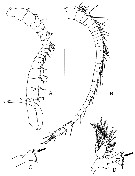 Issued from : V.R. Alekseev & A. Souissi in Zootaxa, 2011, 2767. [p.45, Fig.3]. Female: A, A1 male; C, gnathobase of Md.. Female: B, left A1; D, Md with palp. Arrows indicate separate processor on gnathobase. Scale bar: 125 µm (A, B); 62.5 µm (C, D). Nota: A1 25-segmented, reaching end of 3rd thoracic somite. Setation of segments beginning from 1st segment: 0/4/4/3/1/3/1/4/1/3/1/ 3/3/2/3/2/3/2/2/3/1/1/2/3/7. Most segments with 2 and more setae provided with 1 aesthetasc, last (distal )segment with 6 setae and 1 aesthetasc. - Md composed of coxa with gnathobase, one of its tooth (outermost) significantly larger than other and separated from them. Coxa in middle with biramous mandibular palp, basis with 4 setae, 8-segmented exopod and 5-segmentd endopod. Distal segment of exopod with 2 sub-equal setae, other segments bearing single long seta each. Distal segment of endopod with 2 long setae and 1 short seta, other segment with 2 long setae each. - Right A1 male 21-segmented, 4 and 6 segments without setae, 7-12 segments with strong spines, strongest spine (twice as long as any other spine) at segment 12: 19-20 segments with denticulate plates at inner edges, distal segment with several sensitive papilla. Other segments with regular setae. Left male A1 25-segmented armed as in female.
|
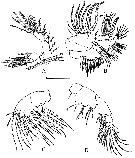 Issued from : V.R. Alekseev & A. Souissi in Zootaxa, 2011, 2767. [p.46, Fig.4]. Female: A, A2; B, Mx1 (ventral); C, Mx2; D, Mxp. Scale bar: 50 µm. Arrow indicating seta segmentation. Nota: Mx1 composed of praecoxa with medial arthrite bearing 10 strong claw-like spines, 6 relatively long setae; coxa with elongated endite bearing 5 long and 1 short setae and outer outgrowth with 7 very strong sub-equal in length setae and 2 thin setae; basis composed of basal endite, 1-segmented endopod with 10 long subequal setae and 4-segmented exopod bearing 5-5-4-7 (distally) long setae. - Mx2 uniramous, composed of ptaecoxa with 2 endites; distal endite bearing 3 long setae, 1st segment with 3 setae; coxa with 2 endites bearing 3 long setae each, and 5-segmented endopod including basal endite with 3 setae and 4 short segments bearing 2 and 3 long distal setae. - Mxp uniramous and 9-segmented, composed of short praecoxa with 1 seta and long coxa with 3 hill-shaped endites bearing 2-3-3 setae; basis more wide in distal part with 3 long setae and with group of long hairs; endite with 3 long setae followed with 5-segmented endopod armed with 2-3-4-3-4 (distally) setae.
|
 Issued from : V.R. Alekseev & A. Souissi in Zootaxa, 2011, 2767. [p.47, Fig.5]. Female: A, left P1 (anterior view); B, P2 (anterior); C, P3 (anterior); D, P4 (anterior). Scale bar: 100 µm. Arrow indicating seta segmentation. Nota: Rudimentary P5 uniramous and 4-segmented, narrow coxal plate bearing 1-segmented basis with strong inner outgrowth and 2 spines, distal spine slightly longer than first one. 1-segmented exopod with long apical seta and lateral spine about half of apical seta. Tiny spine inserted between these 2 appendages about 10% or less of short spine length and shorter than distal spine width in insertion place.
|
 Issued from : V.R. Alekseev & A. Souissi in Zootaxa, 2011, 2767. [p.49, Fig.6, A, B]. Male: A, habitus (dorsal); B, P5 (anterior view); Scale bar: 325 µm (A); 250 µm (B). Nota: Body blue-grey or colorness. - Last thoracic somite without wings and spine on lateral margin. - Abdomen 5-segmented. - Caudal rami 9 times as long as wide without setules or hair-like seta on dorsal and ventral side but with long hair-seta on inner part of cauda. Terminal setae ratio beginning from outermost caudal seta: 1/1.15//1.25/1. Lateral seta about 0.8 times longer than outermost seta, dorsal seta very short, located near innermost seta insertion place. - P5 rudimentary: Right leg with basipodal segment cylindrical in shape and with small hill on inner side pointed with long spine, distal bent segment with several sensitive pores and 2 short spines in middle. left leg basipod cylindrical about 1.45 times as long as wide, next exopodal segment with 2 long spines in middle part, distal segment with strong long spine in middle and hook in end similar in construction to E. affinis.
|
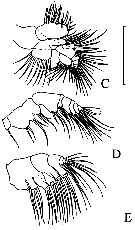 Issued from : V.R. Alekseev & A. Souissi in Zootaxa, 2011, 2767. [p.49, Fig.6, C-E]. Male: C, Mx1 (anterior view); D, Mxp (anterior view); E, Mx2 (anterior view). Scale bar: 125 µm. Nota: Md of same construction as in female. - Mx1 basically as in female, with praecoxa bearing 8 strong claw-like spines, 6 relatively long setae; coxa with elongated endite bearing 6 long setae and outer outgrowth with 9 very strong subequal in length setae; basis composed of basal endite; 1-segmented endopod with 10 long subequal setae and 4-segmented exopod bearing 5-5-4 (distally) long setae. - Mx2 similar to female; praecoxa with 2 endites, distal endite with 3 long setae, 1st segment with 3 setae; coxa with 2 endites bearing 3 long setae each and 5-segmented endopod including basal endite with 3 setae and 4 short segments bearing 2 setae, distal segment with 4 setae. - Mxp 9-segmented, composed of short praecoxa with 1 seta and long coxa with 3 hill-shaped endites bearing 2-2-3 setae; basis more wide in distal part with 3 long setae and with group of long hair-setae near setae insertion place; endopod 5-segmented with 2-2-4-3-4 (distally) setae.
|
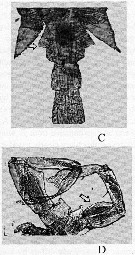 Issued from : V.R. Alekseev & A. Souissi in Zootaxa, 2011, 2767. [p.53, Fig.9, C, D]. Eurytemora carolleeae (Photo: Mrs N. Sukhikh): C, female genital somite with wing-like outgrowth; D, male P5 with arrow indicating left basipod. Nota: Compare with Eurytemora affinis (Poppe, 1880). Females E. carolleeae are equiped with wing-like outgrowths of the genital double-somite that significantly increases the proportionbetween anterior and posterior parts of the somite.
|
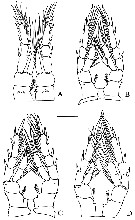 Issued from : V.R. Alekseev & A. Souissi in Zootaxa, 2011, 2767. [p.50, Fig.7]. Male: A, P1 (anterior view); B, P2 (anterior); C, P3 (anterior); D, P4 (anterior). Scale bar: 100 µm. Nota: Swimming legs P1-P4 constructed basically like in female. Distal spines in exopod P1-P4 not so strong in middle part as in female, slightly shorter than nearest setae and longer than distal segment length. Lateral edge of coxa in P1-P4 groups of long hair-setae. Both sides of P1-P4 covered with very short hair-setae.
|
 Issued from : V.R. Alekseev & A. Souissi in Zootaxa, 2011, 2767. [p.51, Table 2, 3, 4]. Table 2: Selected morphometric indexes in females of E. carolleeae Alekseev & Souissi, 2011 from the type locality. Mean + standard deviation (Min-Max). In bold - significant difference with p<0.05.* Only in one female among 56 examined, possibly an aberrant specimen. Table 3: Selected morphometric indexes for E. carolleeae in male from the type locality. Mean + standard deviation (Min-Max). Table 4: Selected morphometric indexes in female and male E. carolleeae from the type locality (Chesapeake Bay, USA). Nota: P5 has a very small (tiny) spine in the 2nd exopodal segment placed between two distal spines. The length of this tiny spineis less than the width of the nearest spines, or about 10% of the short distal spine length (Table 2). In males of E. carolleeae the caudal rami are naked on both dorsal and ventral sides; left rudimentary P5 with exopod of cylindrical shape, and length/width proportion not less than 1.25 times.
| | | | | Loc: | | | N Atlant. (Chesapeake Bay, St Lawrence estuary), Loire River estuary, Seine River estuary,invasive in the Baltic Sea, possibly as in inland waters from Great Lakes to Mexico
Type locality: 39°23.81' N, 76°03.32' W. | | | | N: | 1 | | | | Lg.: | | | (1197) F: 1,655; M: 1,780; {F: 1,655; M: 1,780} | | | | Rem.: | After Alekseev & Souissi (2011, p.41) the new species from the Chesapeake bay (USA) belongs to the Atlantic clade of the Eurytemora allinis complex, outlined by previously publisher molecular work but poorly characterized morphologically. Several important morphological characters separate the North American R. affinis from the European clade that include both sexes: a large outside orientated tooth on the mandible, and cleatly observable seta segmentation in the caudal rami and swimming legs. Unlike E. affinis, the newly described species possesses wing-like outhgrowths on the genital double-somite and a very small spine near the distal seta insertion point in P5 in females. In males, the specific characters include naked dorsal and ventral sides of the caudal rami, and a cylindrical shape of exopod on the left P5, in contrast to a triangular shape of the segment in E. affinis.
See Tables of selected morphometric indexes in female and male to Eurytemora affinis (Poppe, 1880).
See to Eurytemora affinis complex, key of the sibling species. | | | Last update : 19/06/2023 | |
|
|
 Any use of this site for a publication will be mentioned with the following reference : Any use of this site for a publication will be mentioned with the following reference :
Razouls C., Desreumaux N., Kouwenberg J. and de Bovée F., 2005-2025. - Biodiversity of Marine Planktonic Copepods (morphology, geographical distribution and biological data). Sorbonne University, CNRS. Available at http://copepodes.obs-banyuls.fr/en [Accessed December 31, 2025] © copyright 2005-2025 Sorbonne University, CNRS
|
|
 |
 |












